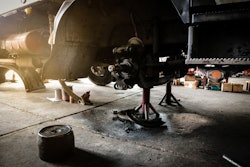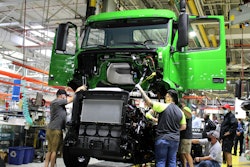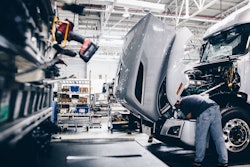
“Purpose built” is simply defined by Merriam-Webster as “built for a particular purpose.”
A paring knife is purpose built with a short-curved blade specifically to pare fruit. You probably could use it to cut a loaf of bread, but why would you when you can have a bread knife purpose built for that loaf?
There are a lot of purpose-built trucks out there, often referred to as work trucks. Utilities use bucket trucks to access powerlines. Waste haulers use garbage trucks. E-commerce deliveries use box trucks. Each of these has been optimized for their specific vocation.
Class 8 tractors are the Swiss Army knife of trucks. Designed to pull a trailer, they mostly don’t care what that trailer is — a dry van, refrigerated van, 28’, 45’ 48’, 53’, flat bed, drop, tanker, bulk carrier, car carrier, soft side, container chassis, dump, livestock, pole, you name it — if it has a king pin, odds are a Class 8 tractor can probably pull it.
Pulling it efficiently, now that’s a different story all together.
The industry has been trending towards specialization for first owner duty cycle for a long time. Fuel efficient aerodynamic tractors really took off in the 1990s. A combination of market and regulatory forces has continuously optimized this segment through today. These aerodynamic tractors have optimized powertrains for on-highway pulling dry and refrigerated van trailers, themselves also often equipped with aerodynamic treatments.
These highway flyers are less well optimized for second, third and fourth buyers. Yes, they can probably pull most any trailer, but they are not as well suited for those other duty cycles.
The North American truck makers have thousands of options available for tractors, and this creates millions of possible permutations. I described this before in a CCJ commentary "The average truck."
Standing on a truck production line almost always causes a visitor to comment that every truck seems to be completely different than the one before or after. Option complexity exists because the market values specialization. Now, throw in a range of new technologies — battery electric, fuel cell hybrid electric, RNG hybrid electric, and a range of other new powertrain alternatives we’ve collectively called the "messy middle." Toss in automated and connected technologies, trucks without human drivers. Each new technology brings with it tradeoffs, decisions that have to be made on prioritizing for first owner performance and duty cycle.
I expect we will see even greater specialization moving forward. Each new truck will be specified for a particular duty cycle, around available or planned infrastructure, with regional influences due to regulations, incentives, credits, public acceptance and available energy types. That really is nothing new.
What is new, is that the second, third and fourth buyer for these vehicles will be even more challenged to operate these used vehicles efficiently in their completely different duty cycles.
Used truck buyers do not have the luxury of spec’ing exactly what they want to buy. They have to pick from the available pool of used vehicles previously specified by the first owner. When demand is high, like this year, they can’t pick and choose. They have to grab up whatever stock is available.
[Related: Used truck market 'completely nuts']
You see this in drayage and bulk haulers like gravel, where used trucks tend to be in demand. These duty cycles are significantly different than the highway flyers, but those highway flyers are the used trucks they have to buy. It’s not uncommon to see a high roof sleeper pulling a gravel truck where the sleeper never gets used. Take a photo at any port facility and you will see a range of tractor models and configurations.
There will come a point where the level of optimization may be too much for the used market buyers. Too many compromises between the first owner and the downstream buyers. NACFE has reported on battery electric and fuel cell electric trucks. I’ve written in CCJ that these are not really competitors for the same markets, but alternatives to help replace parts of the diesel spectrum. Each of these alternative powertrains optimizes better for different duty cycles, a different sweet spot where they operate best.
Put this in perspective of automotive market segmentation. Yes, you can compare a Tesla Model S sedan to a Ford F-150 Lightning, but these really are two different vehicles with two different purposes.
I drove my pickup to Lowe’s the other day and saw a MY2022 Corvette there. I asked my wife, where does the owner expect to put 20 bags of mulch? Comparisons of sub-compacts to SUVs, where the only metric of concern is fuel economy, has always rankled me. Yes, the Prius gets 58 mpg but its maximum freight capacity is about 800 lbs., and try to fit a 4x8 sheet of plywood in it. Apples and oranges comparisons abound.
Another market change coming is life span of the vehicle. Battery electric trucks and fuel cell hybrid electric trucks both are expected to have changes to life spans.
Batteries, fuel cells, and high-pressure tanks and system may require replacement by downstream users. This is not new to trucking. Diesel engines also get to a point where major service is required. But will it make sense to overhaul 10-year-old technology or just get a new unit that benefits from 10 years of improvements? This question is being answered in California where older diesel trucks by regulation are being replaced with newer, more efficient ones.
And what if the claims that battery electric and hybrid electric trucks have less maintenance are true? What if these vehicles cost 30%, 40%, or 50% less to maintain? Doesn’t that hint that they may be less in need of first owner trade-in at five years? Maybe the first owner is the only owner. Maybe there are no used trucks in the future?
Automation is another technology trend.
How will automation technology impact trade cycles? One of the primary reasons I’ve heard for trading in a truck is that the cab interiors need to be updated after five years of heavy driver use.
Wear and tear, odors, pets, etc., are hard on vehicle interiors. An automated truck doesn’t have a driver. The computers don’t care what the interior of the truck looks or smells like. The computers don’t need a new mattress, cup holder, microwave or television. Knobs, switches, buttons, etc. are less apt to fail with no one to push them. Automated trucks may have no cab at all.
I predict automated trucks will be even more likely to stretch out first ownership. Think in terms of computers and smart phones. How many of us buy 10-year-old laptops or even 5-year-old cell phones?
Many forces are contributing to vehicles being optimized for their first owner’s duty cycle. In other words, purpose built. Will these new technologies disrupt truck trade cycles? Will they influence used truck buyers to become new truck buyers? I expect these new alternative powertrain and automated trucks will change the market. Trucking is always evolving. Change is to be expected. This trend towards purpose-built vehicles may have a significant impact on how we spec, buy, sell and dispose of trucks.
Rick Mihelic is NACFE’s Director of Emerging Technologies. He has authored for NACFE four Guidance Reports on electric and alternative fuel medium- and heavy-duty trucks and several Confidence Reports on Determining Efficiency, Tractor and Trailer Aerodynamics, Two Truck Platooning, and authored special studies on Regional Haul, Defining Production and Intentional Pairing of tractor trailers.












